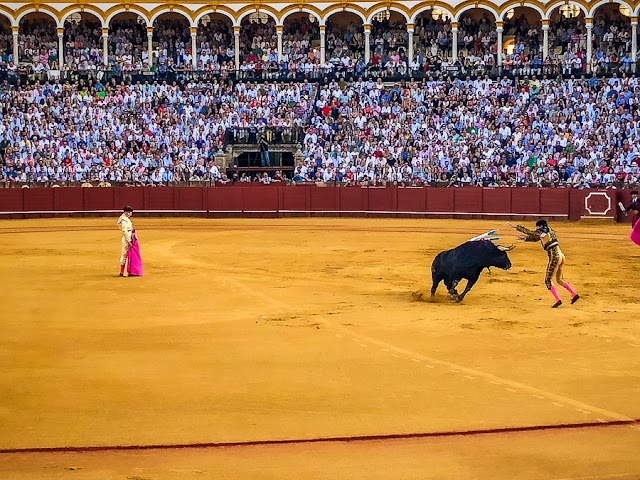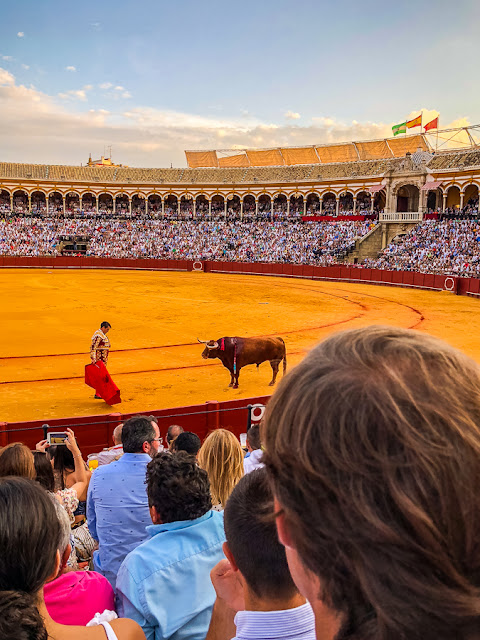My afternoon at the corrida de toros - WARNING: you may not wish to read this.
Spanish-style bullfighting, also known as a corrida de toros, is something that I had attempted to observe on two occasions in the past, but for one reason or another, I was not able to attend.
The first time I held tickets in my hand was in 1990. We were living in Brussels, and I was attending a FEICA meeting in Sevilla. FEICA is the Association of the European Adhesive and Sealant Industry. I was working in the industrial adhesives business for 3M Company at the time. The corrida was to start at 6:00 PM, and the meetings were running a bit long. Meetings finally over, we dashed out to the street, hailed a taxi and headed to the la plaza de toros. We arrived about 15 minutes late. There was a crowd milling around the outside of the plaza de toros. A hand written note was attached to the main entry door. With some help from a local, I discovered that the veterinarian, el veterinario, had declared the bulls unfit for the fight. No refunds were available, only rain checks. I wasn't in a position to return from Brussels. I sold my rain checks at a great loss to one of the locals. My disappointment was bigger than the monetary loss.
In 1992, I had another chance to have my Ernest Hemingway moment at the corrida de toros. I was still living in Brussels. A stay in Sevilla was part of a 2 week vacation in Spain and Portugal. I had tickets for the corrida de toros, but I was called back to Brussels for a one day emergency meeting. I flew to Brussels on the eve of the corrida de toros and returned on day after the date on the tickets.
This year, we find ourselves in Sevilla once again. We rented an apartment for a month. To my amazement, the corrida de toros was to have its final event of the year during our stay. I was alone in my desire to have this Spanish experience. I purchased my single ticket 2 days in advance of the spectacle.
The first time I held tickets in my hand was in 1990. We were living in Brussels, and I was attending a FEICA meeting in Sevilla. FEICA is the Association of the European Adhesive and Sealant Industry. I was working in the industrial adhesives business for 3M Company at the time. The corrida was to start at 6:00 PM, and the meetings were running a bit long. Meetings finally over, we dashed out to the street, hailed a taxi and headed to the la plaza de toros. We arrived about 15 minutes late. There was a crowd milling around the outside of the plaza de toros. A hand written note was attached to the main entry door. With some help from a local, I discovered that the veterinarian, el veterinario, had declared the bulls unfit for the fight. No refunds were available, only rain checks. I wasn't in a position to return from Brussels. I sold my rain checks at a great loss to one of the locals. My disappointment was bigger than the monetary loss.
In 1992, I had another chance to have my Ernest Hemingway moment at the corrida de toros. I was still living in Brussels. A stay in Sevilla was part of a 2 week vacation in Spain and Portugal. I had tickets for the corrida de toros, but I was called back to Brussels for a one day emergency meeting. I flew to Brussels on the eve of the corrida de toros and returned on day after the date on the tickets.
This year, we find ourselves in Sevilla once again. We rented an apartment for a month. To my amazement, the corrida de toros was to have its final event of the year during our stay. I was alone in my desire to have this Spanish experience. I purchased my single ticket 2 days in advance of the spectacle.
Plaza de toros de la Real Maestranza de Caballería de Sevilla
Okay, so far not too disturbing. There is more to come, but first, a little info on the structure of the fight. The bullfight is not something that happens every week or every month, for that matter. In Sevilla, it happens about 4 times a year. The fight covers 3 days. Each day 3 matadors face 2 bulls each for a total of 6 bulls. The first of the 3 days is for the lesser matadors; the third day is for the most accomplished. My ticket was for Sunday, the third day. Ticket prices vary depending on distance from the ring and if the seat is in sun or shade. I chose the shade and row four. Row four is actually seven rows from the ring. There are three rows of box seats close to the ring.
I thought the corrida de toros started at 6:30 PM; it actually started at 6:00 PM. One cannot be seated after the fight starts. One must wait until the tercios of a fight are complete. There is a brief time when the late patrons are allowed to go to their seats. If there are lots of late comers, all will not get to there seats before the second matador enters the ring. I missed the first two matches.
I missed the first 2 fights while waiting in the tunnel
When I did enter the plaza de toros, I found that there are no aisles. You just ask to pass, people move and you step on the benches up to your row. Then find the seat number and everyone squeezes over to allow you to sit.
the surface is smoothed out after each fight
The modern corrida is highly ritualized, with three distinct stages, tercios, or thirds. The start of each is announced by a bugle sound. The participants enter the arena in a parade, paseíllo, to salute the presiding dignitary, accompanied by band music.
If you don't like the idea of the bull being injured, STOP READING NOW.
If you don't like the idea of the bull being injured, STOP READING NOW.
Tercio de Varas: The bull enters the ring, where he is tested for ferocity by the matador and banderilleros using a large, magenta and gold cape, capote. The matador is assessing the bull at this stage. The picador enters the arena on horseback armed with a lance, vara. To protect the horse from the bull's horns, the animal wears a protective, padded covering called peto. The picador uses the vara to weaken the neck muscles of the bull. This helps keep his head down.
using the capote
the picador
Tercio de Banderillas:Three banderilleros each attempt to plant two banderillas, sharp barbed sticks, into the bull's shoulders. These anger, agitate, and further weaken the bull.
banderillero
banderillero
Tercio de Muerte: The matador takes center stage alone with a small red cape, muleta, and a sword, estoque. The matador attracts the bull and performs a series of passes showing his skill in an interesting and graceful display, faena. The faena refers to the entire performance with the cape, muleta. The passes with the cape are broken down into tandas, a series of passes. A final series of passes where the matador, using the cape, maneuvers the bull into a position to stab it between the shoulder blades and through the aorta or heart. The act of thrusting the sword is called an estocada.
The last matador started the fight from his knees. After a few passes, he was on his feet.
It never ends well for the bull. I decided not to include images of the final action of the matador.
the matadors leave the ring in a final procession at the end
A few final thought on finally getting to witness a corrida de toros.
- I wish I had arrived on time. I missed the first 2 of the 6 matches.
- There is a pageantry and grace about the entire performance that cannot be denied. Of the 4 matadors that I saw, only one received high accolades from the crowd. A superior performance is followed by the crowd vigorously waving white handkerchiefs.
- The crowd was mixed from old to young, and nearly equal numbers of men and women.
- I can see why Hemingway and Picasso were drawn to this man against beast performance. It suited their personalities.
- I don't think I need to see another corrida de toros. One was ample.
PS: I only had my phone to capture photos. I did not wish to take a camera. I wanted to try to take in the entire event without focusing on taking pictures. The phone stayed in my pocket most of the time.



















I went to one a long time ago, I wasn't too impressed at the time. But recently sitting in a bar/restaurant in Albacete I was fascinated by a group of men watching una corrida on TV. Reminded me of Americans watching football, or maybe baseball since it was summer!
ReplyDeleteSaw my bullfights in 1977 on junior high School European trip; the Matadore doesn't always win. One was gored right through the upper thigh, but survived. It was thrilling not really knowing what might happen next. The fans were very respectful of the whole process. I too got it out of my system, by the end of the day. Spent the next day in Toledo.
ReplyDeleteMartha, if one can block out the injury to the bull (not an easy thing to do) there is a kind of ritual, art and grace that everyone in the ring and in the seats seems to participate.
ReplyDeleteByron, I agree. In one of the fights, the matador was thrown in the air by the bull. He had a very small nick on his thigh, but not bleeding very much. However, his shoes were still on the ground, ten feet away (or was it 3 meters?). The other men with capes distracted the bull and helped re-shoe the matador. He finished the fight, but was not as graceful in finishing off the bull.
ReplyDelete